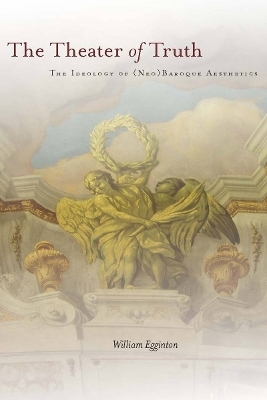
The Theater of Truth
The Ideology of (Neo)Baroque Aesthetics
Seiten
2009
Stanford University Press (Verlag)
978-0-8047-6954-9 (ISBN)
Stanford University Press (Verlag)
978-0-8047-6954-9 (ISBN)
The Theater of Truth is a book for those interested and engaged in the debates around baroque and neobaroque aesthetics, and offers a unified theory for the relation between these terms and a new vocabulary for distinguishing between their ideological values.
The Theater of Truth argues that seventeenth-century baroque and twentieth-century neobaroque aesthetics have to be understood as part of the same complex. The Neobaroque, rather than being a return to the stylistic practices of a particular time and place, should be described as the continuation of a cultural strategy produced as a response to a specific problem of thought that has beset Europe and the colonial world since early modernity. This problem, in its simplest philosophical form, concerns the paradoxical relation between appearances and what they represent. Egginton explores expressions of this problem in the art and literature of the Hispanic Baroques, new and old. He shows how the strategies of these two Baroques emerged in the political and social world of the Spanish Empire, and how they continue to be deployed in the cultural politics of the present. Further, he offers a unified theory for the relation between the two Baroques and a new vocabulary for distinguishing between their ideological values.
The Theater of Truth argues that seventeenth-century baroque and twentieth-century neobaroque aesthetics have to be understood as part of the same complex. The Neobaroque, rather than being a return to the stylistic practices of a particular time and place, should be described as the continuation of a cultural strategy produced as a response to a specific problem of thought that has beset Europe and the colonial world since early modernity. This problem, in its simplest philosophical form, concerns the paradoxical relation between appearances and what they represent. Egginton explores expressions of this problem in the art and literature of the Hispanic Baroques, new and old. He shows how the strategies of these two Baroques emerged in the political and social world of the Spanish Empire, and how they continue to be deployed in the cultural politics of the present. Further, he offers a unified theory for the relation between the two Baroques and a new vocabulary for distinguishing between their ideological values.
William Egginton is Professor and Chair of German and Romance Languages and Literatures at the Johns Hopkins University. He is the author of How the World Became a Stage (2003), Perversity and Ethics (Stanford, 2006), A Wrinkle in History (2007), and The Philosopher's Desire (Stanford, 200
| Verlagsort | Palo Alto |
|---|---|
| Sprache | englisch |
| Maße | 152 x 229 mm |
| Gewicht | 417 g |
| Themenwelt | Geisteswissenschaften ► Philosophie |
| Geisteswissenschaften ► Sprach- / Literaturwissenschaft ► Anglistik / Amerikanistik | |
| Geisteswissenschaften ► Sprach- / Literaturwissenschaft ► Literaturwissenschaft | |
| ISBN-10 | 0-8047-6954-0 / 0804769540 |
| ISBN-13 | 978-0-8047-6954-9 / 9780804769549 |
| Zustand | Neuware |
| Haben Sie eine Frage zum Produkt? |
Mehr entdecken
aus dem Bereich
aus dem Bereich
Poetik eines sozialen Urteils
Buch | Hardcover (2023)
De Gruyter (Verlag)
CHF 83,90
Buch | Softcover (2024)
belleville (Verlag)
CHF 27,95


